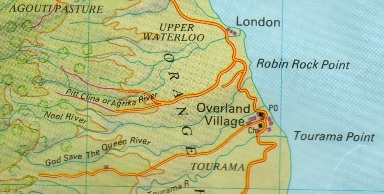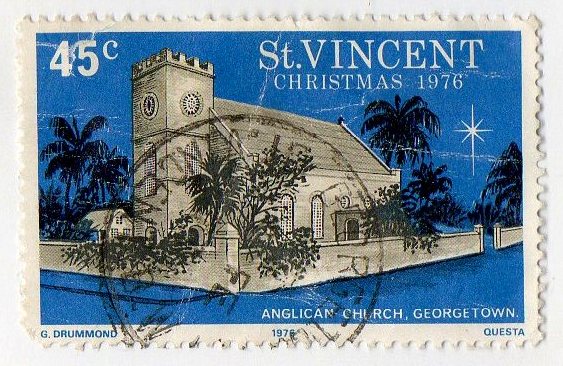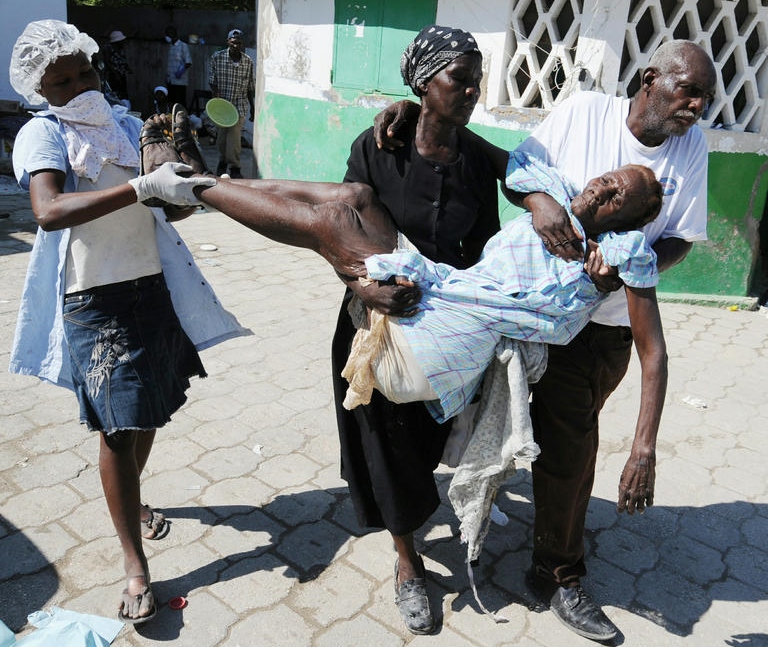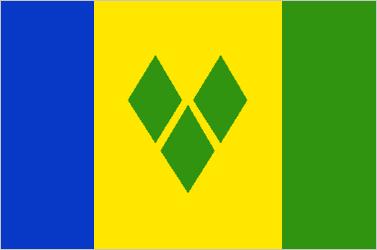
" School should not be a preparation for life, school should be life"
The First Kingstown Hospital
The Kingstown, hospital was established in 1841 to cater for the old and disabled, both as resident patients and out patients. Those with infectious diseases, however, were not admitted until 1861, and the mentally ill were left to roam the streets or were sent to the jail. According to Charles Day, the streets of Kingstown were full of people he described as 'crazy negroes', 'daftbodies' and 'naturals'.
Much of the original cost of the hospital was raised by the affluent women of the island. They held bazaars, craft shows and parties to fund the hospital. Contributions were also made by friendly societies and religious congregations,and a crowd of 4000 watched the laying of the first corner stone. However, a severe lack of funds limited the work of the hospital and, in 1849, the hospital announced that it could no longer take in any new patients or feed any out patients for the rest of the year. In 1855, the hospital was again closed for over nine months due to debts, and it was periodically closed throughout the rest of the decade.It was eventually rebuilt in the 1870s.
Did you know that a song was written about Ebenezer Joshua and the Georgetown sugar cane strike in 1962?
In 1956, when Saint Vincent and the Grenadines gained more autonomy, Joshua became the first Chief Minister. As Chief Minister, he defended the rights of Vincentians and spoke out against outside and colonial rule. Many of the rights and benefits we enjoy, were brought about while Joshua was Chief Minister. Some of the rights and benefits include:
- Holidays with pay
- Increase in wages
- Protection against eviction by insensitive land owners
- Freedom to practice religion
- Protection against child labour
The People's Political Party continued to win elections, and Joshua was said to be much loved by the poor workers. He supported the unsuccessful Federation of the West Indies. Many blamed him for the demise of the Sugar Factory in Georgetown. In 1964 he decided to discontinue support for the sugar growers and close the St. Vincent Sugar Mill as a result of steady losses which had happened for several years.
Strikes were rife in Georgetown, during the Sixties and a song was made by Eric von Schmidt, a painter and folksinger to highlight what was taking place during one particular strike. But how much of the words in the song is true? Click here to read more.
St Vincent, born woman becomes National hero of Trinidad and Tobago.
Elma Constance Francois, was born in Overland, St. Vincent in 1897. In her youth she received primary education up to 5th Standard and she worked alongside her mother picking cotton. From an early age she struggled for the betterment of her people since life in St Vincent was very hard for labourers, especially women.
Some found work picking up cotton chaff for which they would receive 12-14 cents a day. Her father, a labourer, died when she was still little. The family lost all their belongings in the volcanic eruption that devastated the island in 1902, and there weren’t any prospects for young women other than working as a domestic servant, picking cotton or finding some sort of employment in the sugar factory at Mount Bentinck.
 Already socially minded as a young teenager, she tried to organise the workers in the sugar factory, which was not met with understanding by the owners of Mount Bentinck, of course, she was fired. Elma moved to Kingstown, where she had a liaison with Albert James. They had a son. In 1919, Elma Francois migrated to Trinidad, leaving her two-year old boy behind in St. Vincent.
Already socially minded as a young teenager, she tried to organise the workers in the sugar factory, which was not met with understanding by the owners of Mount Bentinck, of course, she was fired. Elma moved to Kingstown, where she had a liaison with Albert James. They had a son. In 1919, Elma Francois migrated to Trinidad, leaving her two-year old boy behind in St. Vincent.
First, she had to find an income. The Stollmeyers employed her as a servant in their ‘castle’ on the Savannah. Little did they know that they were housing a future labour leader! She was to later form the National Unemployed Movement in 1934, and in 1935 the Negro Welfare, Cultural and Social Association, which pioneered many forms of public protest for the rights of colonised people.
On September 25, 1987, she was declared as a "National Heroine of Trinidad and Tobago". She had been described as one of the "Vociferous Africentric activists" in the history of Trinidad and Tobago and in the Caribbean region.

Below is a list of Slave Acts passed on December 16th 1825 and Estate owners in Charlotte Parish 1827-1829
The Georgetown Anglican Church was featured in the National Stamp gallery in 1976.
Marriages were not recognised unless it was performed in the Anglican church
Births were first required to be registered in 1864. Sixty Five per cent of black babies were born out of marriage. Not many marriages took place up to 1841, as marriages were only legally recognised if they were performed in the Anglican church. Another reason why people chose not to marry may be attributed to the independence of women. Married women had to obey their husbands, they had no right to own property.
Marriage was sometimes seen as a curse rather than a blessing for many couples because of the husbands' infidelity. There were far too many women than men on the island.
A Modern Day Roll Model From Chester Cottage
Cecil Browne was born in Saint Vincent and the Grenadines in 1957 and came to High Wycombe in 1970. Cecil was one of the first black pupils to attend The Royal Grammar School. Attending University of London where he attained a BSc degree in Maths, he then went on to obtain his Masters in Education at Brunel University. Cecil returned to High Wycombe where he has lectured in mathematics at a local college for the last twenty-five years, eventually becoming the Head of Mathematics. He was one of the founding members of the Caribbean Saturday School in High Wycombe and has been involved with many community programs and activities, the most recent being the organisation of Caribbean Community Day at Adams Park where Wycombe Museum first promoted the launch of the Black and Asian section of its Oral History Project.
Cecil recently published his first book of short stories: "The Moon is Following Me", which is about Caribbean life and is available in the museum shop. He wrote this book hoping to encourage others in his community to tell their own stories, and is now in the process of completing a second edition.
.
Fort Charlotte Canons
Ever wondered why the canons at Fort Charlotte are pointing in land and not at sea. Well the native Caribs on the Leeward side, were more of a threat to the British than anyone else.
SVG First Airport
Ever wondered why your baggage is tagged 'SVD' as the airport destination code for E.T Joshua Airport, especially since 'SVG' had become the popular country code for St. Vincent & the Grenadines since the early 1980's.
Well SVD stands for “St. Vincent, Diamond”. Diamond, was the location of SVG's first airport, between the first and Second World War, hence SVD. In the early 1950's, the decision was made to move the airport, and the entire air transport system, over to Villa and to use sea-planes. The Grumman Goose being the popular airplane at the time.
So, now we landed and took off from the water in front of Villa Beach in the Young Island Channel. The seaplanes landed from the Indian Bay area and came into the airport, then took off after taxiing out to the Indian Bay between Young Island and Villa Beach, heading out into Calliaqua Bay, then off to Seawell in Barbados.

Above from left to right is Diamond Airfield, Villa Sea plane port, The opening of ET Joshua Airport and the new Argyle Airport.
Cholera In St Vincent
"Bacteria are excreted in faeces and if this comes into contact with drinking water, the bacteria can infect people."
There is a long stretch of road from Grand Sable leading to Georgetown, known as Cholera Long Stretch. Most of todays generation may not of heard off this. The area got its name because of the Cholera outbreak in 1853. It is said that this was where many people attempting to get to the Georgetown hospital for treatment, died and were hastily buried.
Cholera arrived from Asia in the 1830s carried by immigrant labour and a regional pandemic was initiated in the 1850s. St Vincent recorded about 15,000 deaths. In Barbados, more than 20,000 died. Cholera hit the poor much harder than the wealthy.
In the 19th-century Caribbean, human excrement was disposed of casually if at all and the poor were most likely to drink from the contaminated water as the rich had their own private, much safer, cisterns and wells.
The symptoms included acute vomiting, very acute diarrhea, muscle cramps, ruptured capillaries that made skin appear blue, and lethargy. Death usually came quickly and brutally. Sadly, those who underwent medical treatment were far more likely to die. The treatment at the time was bloodletting and purging by inducing diarrhea and vomiting, which is diametrically opposed to the rehydration that is now used to cure the disease. The photo above is from the 2010 outbreak in Haiti.
The meaning of the SVG flag colours.
Following June 1984 elections won by the New Democratic Party, Prime Minister James Mitchell commissioned a new flag. Swiss graphic artist Julien van der Wal created a version with the narrow white stripes omitted, leaving a simple vertical  tricolour of blue-yellow-green.
tricolour of blue-yellow-green.  The arms and breadfruit leaf, difficult to distinguish at a distance, were replaced by three green diamonds arranged in the form of a V. They suggest three gems (the islands are known as the “Gems of the Antilles” or the “Jewels of the Caribbean”), and the V shape is an indirect reference to the first letter of Vincent. The colour symbolism is unchanged from the original flag. Green is for the rich vegetation of the islands and the vitality of their people; yellow stands for golden sands and personal warmth; and blue is for sea and sky. The new flag was officially hoisted on October 22, 1985.
The arms and breadfruit leaf, difficult to distinguish at a distance, were replaced by three green diamonds arranged in the form of a V. They suggest three gems (the islands are known as the “Gems of the Antilles” or the “Jewels of the Caribbean”), and the V shape is an indirect reference to the first letter of Vincent. The colour symbolism is unchanged from the original flag. Green is for the rich vegetation of the islands and the vitality of their people; yellow stands for golden sands and personal warmth; and blue is for sea and sky. The new flag was officially hoisted on October 22, 1985.
Is it by coincidence that our national bird has simular coloured feathers as the flag?
The Silk Cotton Tree
The huge and imposing silk cotton tree is found in many parts of the Caribbean forest. It also grows in West Africa and the East Indies. Silk cotton wood has been used to make coffins, cricket bats, and much earlier, canoes. One of the Spanish names for the tree is “ceiba” which comes from the Spanish name for canoe.
The silk cotton has never become commercially important in the Caribbean, but it is significant that it has been held in great dread by people from several cultural backgrounds. The tree has been held sacred by the ancient Mayas, by people who have originated in Africa In some Caribbean countries. The silk cotton tree was often called the “God tree’ or the “Devil tree.” In Guyana, it has been called the “Jumbie tree.” The tree has been regarded by some as having a soul or a resident spirit. But it was most often considered to be associated with the souls of the dead, living possibly in its roots and branches.
In Jamaica, it was said that the Spanish would bury treasure under a silk cotton tree, then kill the slave who buried it, so that the slave’s spirit would guard the treasure and no one would dare dig for it. The same story is told in Guyana, except that it was the Dutch, rather than the Spanish, who would use this method to guard treasure. The Halfway Tree, which gave its name to a district in Kingston, was a silk cotton tree which dated from the British Conquest of 1655 and survived until the late 19th Century.
According to legend, Gang Gang Sara, the African witch of Tobago, climbed a silk cotton tree in Les Coteaux and tried to fly back to Africa. She forgot that because she had eaten salt (reminiscent of the ol’ higue or hag or sucouyant) she could no longer fly. Gang Gang Sara, died instantly. Her grave is one of the tourist sites in Tobago.
Obeah men claimed to be able to cast a spell by driving a nail into a silk cotton tree, then call on an evil spirit to cause someone’s soul to leave his body and live in the tree.
In some areas no one would dare cut down a silk cotton tree. In others, before cutting down a silk cotton tree, village folk would pour a libation on its roots or ceremonially make an offering of corn, or sacrifice a chicken.
Commercially, the silk cotton tree, is cultivated in some tropical regions for its fiber, known as kapok. The cotton-like kapok is exposed when the fruits burst open while still on the tree. Because the fiber is short, elastic and brittle, it cannot be spun like cotton but is used in various ways in upholstery and in making floss. Its light and water-repellent properties make it suitable for use in life preservers and as stuffing and insulation.
Information taken from silvertorch.com
